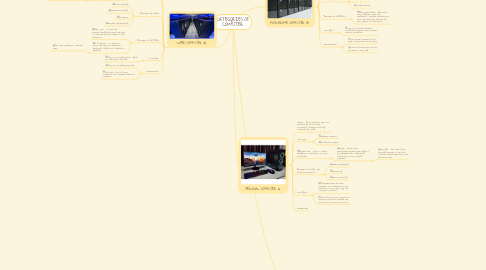
1. SUPER COMPUTER
1.1. Define - The fastest , most powerful and most expensive computer .
1.2. ▪️Physical size - Full room of equipment
1.2.1. ▪️Speed - Capable of processing more than one quadrillion instruction in a single second
1.2.1.1. ▪️Storage - Supercomputers are designed with a large number of processors
1.3. 👈🏻 Examples of usage
1.3.1. ▪️Online banking
1.3.2. ▪️Automotive design
1.3.3. ▪️Aerospace
1.3.4. ▪️Weather forecasting
1.4. 👈🏻 Examples of ACTION
1.4.1. ▪️IBM Mira - it runs the climate change scenarios and helps in research of kore efficient car batteries
1.4.2. ▪️K Computer - it works on atom and electron simulation useful for effect of tsunami on buildings
1.4.2.1. ▪️Run more problems in shorter time
1.5. 👈🏻 Strength
1.5.1. ▪️They are incredibly fast , good for scientific research
1.6. 👈🏻 Weaknesses
1.6.1. ▪️They sre incredibly expensive
1.6.2. ▪️They use a lot of power compared to a standard business computer
2. ▪️Lack of processing power
3. MAINFRAME COMPUTER
3.1. Define - A large , expensive , powerful computer that can handle hundreds or thousands of connected users at the same time
3.2. ▪️Physical size - Partial room to a full room of equipment
3.2.1. ▪️Speed - Powerful computer that handle hundreds or thousands of connected users at the same time
3.2.1.1. ▪️Storage - Stores tremendous amounts of data , instructions and information
3.3. Examples of usage 👉🏻
3.3.1. ▪️Hospitals
3.3.2. ▪️Univerrsities
3.3.3. ▪️Large business
3.4. Examples of ACTION 👉🏻
3.4.1. ▪️IBM System/370 - Allowing an easy migration path for customers , improve performance were the dominant themes of the product announcement
3.5. Strength 👉🏻
3.5.1. ▪️Lots of processes because mainframe support several dozen central processors
3.6. Weaknessses 👉🏻
3.6.1. ▪️Mainframe accupies lot of space and produce lot if heat
3.6.2. ▪️Cost of mainframe and its hardware is very high
4. PERSONAL COMPUTER
4.1. Define - Is a computer that can perform all of its input , processing , output & storage activities by itself
4.2. Two type 👉🏻
4.2.1. ▪️Desktop computer
4.2.2. ▪️Notebook computer
4.3. ▪️Physical size - Fits on a dest (desktop & notebook) , on a lap (notebook)
4.3.1. ▪️Speed - Slower than mainframe because the usage is by individuals for organizing information and creating products
4.3.1.1. ▪️Storage - The size of the storage depends on the user needs & various depends on the hard drive size
4.4. Examples of usage ( use personal computer ) 👉🏻
4.4.1. ▪️Desktop publishing
4.4.2. ▪️Accounting
4.4.3. ▪️Word processing
4.5. Strength 👉🏻
4.5.1. ▪️Privatized data because computer not hooked up to the internet or any other type of network connection
4.5.2. ▪️Less risk of virus , spyware & malware infection because the lack of an internet connection

